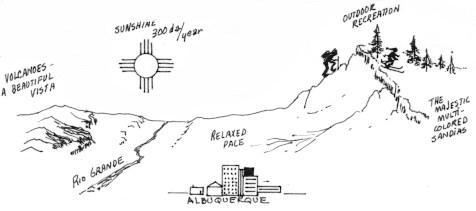With the establishment of Sandia Base during World War II, and the resulting influx of new residents, Albuquerque quickly developed into a full-fledged city. The "good life" of sunshine, healthy air, and scenic vistas was supplemented by the amenities and vitality associated with life in other metropolitan areas. The city became diverse and cosmopolitan, culturally and aesthetically stimulating, while continuing to enjoy many of the attributes of a small town.
At the same time that urbanization was adding a new dimension to Albuquerque's attractiveness as a place to live, many older American cities were entering a period of rapid deterioration. Poverty, slums, racial tensions, crime, alienation, flight of the middle class, and pollution fed on each other in the familiar syndrome of urban decay.
 People
wanted to leave the old Eastern cities. A Harris poll in the mid-seventies indicated
that many people living in large cities desired to live somewhere else. Of those
who said that they wanted to move, the general response was a desire to move
to a quieter, smaller, slower paced environment.
People
wanted to leave the old Eastern cities. A Harris poll in the mid-seventies indicated
that many people living in large cities desired to live somewhere else. Of those
who said that they wanted to move, the general response was a desire to move
to a quieter, smaller, slower paced environment.
Many of these people moved to the Sunbelt states of the South and West. Disturbing parallels can be drawn between this new migrant and the familiar one of a century or more ago. The same buffalo-hunter mentality was apparent to some degree:
But there are also differences between the new migrant and the buffalo hunter. Twentieth-century escapees from the Northeast and Midwest were generally better educated, more affluent, had more professional skills, and did not come seeking their fortunes. They relocated for different reasons. They were in search of a slower lifestyle, more open space, and, in general, a more a more "human scale" environment.
(Up to Introduction, Back to Why Live in Albuquerque?, On to Albuquerque's Growth)